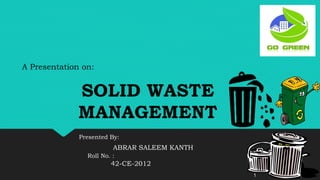solid waste management by abrar saleem
- 1. SOLID WASTE MANAGEMENT 1 ABRAR SALEEM KANTH Roll No. : 42-CE-2012 A Presentation on: Presented By:
- 2. Solid waste Types of solid waste Sources of solid waste Effects of solid waste solid waste management Storage Collection waste handling and transport method of disposal Concept of 3R CONTENTS
- 4. Examples of Solid Waste
- 5. E-Wastes Industrial wastes Bio-medical wastes Agricultural wastes Municipal Solid wastes Classification of Solid Waste
- 6. Municipal Solid wastes: Solid wastes that include household garbage, rubbish, construction & packaging materials, etc. and are managed by any municipality. Bio-medical wastes: Solid or liquid wastes including containers, products generated during diagnosis, treatment & research activities of medical sciences. Industrial wastes: Liquid and solid wastes that are generated by manufacturing & processing units of various industries like chemical, petroleum, coal, metal gas, paper etc. Agricultural wastes: Wastes generated from farming activities. These substances are mostly biodegradable. E-wastes: Electronic wastes generated from any modern establishments. They may be described as discarded electrical or electronic devices. Some electronic scrap components, such as wires, circuits, mobile, computers etc. Classification of Solid Waste
- 7. E-Wastes Agricultural wastes Bio-medical wastes Industrial wastes
- 9. Muncipal solid waste generation in india
- 10. 7.2 million tonnes of hazardous waste. One Sq. km of additional landfill area is needed every-year. Rs 1600 crore for treatment & disposal of these wastes. In addition to this industries discharge about 150 million tonnes of high volume low hazard waste every year, which is mostly dumped on open low lying land areas. Solid Waste in India
- 11. In Mumbai (2005) the sewage line is cloged due to large no. of plastic bags. Blast in the Bhusan Steel factory at Noida, caused due to imported scrap from Iran. Reduction in the number of migratory birds due to consumption of contaminated foods. Animals dying on streets due to consumption of plastic bags, which blocks the food movement in their stomach . How solid waste affected us in recent years?
- 12. Impacts of solid waste on health Nausea and vomiting Low birth weight Cancer Chemical poisoning through chemical inhalation Increase in hospitalization of diabetic residents living near hazard waste sites Mercury toxicity from eating fish with high levels of mercury Impacts of Solid waste on health
- 13. Population growth Increase in industrials manufacturin g Urbanization Causes of increase in solid waste
- 14. Waste management is the storage collection transport and handling recycling disposal and monitoring of waste materials. Solid waste management
- 15. Storage: - Galvanized steel dust bin - Paper sack - Public bins storage
- 16. Collection - House-to-house collection - Collection from the public bins collection
- 17. Waste handling and separation involves activities associated with waste management until the waste is placed in storage containers for collection. Handling also encompasses the movement of loaded containers to the point of collection. waste is transferred from a smaller collection vehicle to larger transport equipment Waste handling and transport
- 18. 1. Dumping 2. Controlled Tipping or Sanitary Landfill 3. Incineration 4. Composting 5. Manure pits 6. Burial Method of disposal
- 19. It is the most traditional method of waste disposal. Waste is directly dumped into quarries, mining voids or borrow pits. Disposed waste is compacted and covered with soil. It is generally used for domestic waste. Land Filling
- 20. A Land Fill Site
- 21. Incineration is a waste treatment process that involves the combustion of solid waste at 1000^o C. waste materials are converted into ash, flue gas, and heat. The ash is mostly formed by the inorganic constituents of the waste and gases due to organic waste. The heat generated by incineration is used to generate electric power. Incineration
- 22. Incineration
- 23. Know 3R’s Concept and Justify Aspects and Issues related to recycling and composting of municipal solid waste (MSW). How can we make a change
- 24. Reduction • By reducing, consumer and industry can save natural resources and reduce waste management costs. Reuse • Large production companies such as Electronic, appliances and gadgets, should establish the collection centre, where damaged items can be repaired and reuse. Recycling • Recycling turns materials that would otherwise become waste into valuable resources.
- 25. Waste generation and waste reduction reflect many complex economic and social factors. No city or town can adopt recommendations in a vacuum; each must examine its own wastes, and the potential for extending waste reduction. Conclusion
- 26. Thank You..

